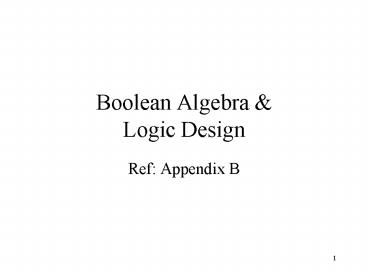Boolean Algebra - PowerPoint PPT Presentation
1 / 44
Title:
Boolean Algebra
Description:
... Boolean Algebra to solve problems in electronic circuit design. ( 1938) ... Digital logic circuits are electronic circuits that are implementations of some ... – PowerPoint PPT presentation
Number of Views:42
Avg rating:3.0/5.0
Title: Boolean Algebra
1
Boolean Algebra Logic Design
- Ref Appendix B
2
Boolean Algebra
- Developed by George Boole in the 1850s
- Mathematical theory of logic.
- Shannon was the first to use Boolean Algebra to
solve problems in electronic circuit design.
(1938)
3
Variables Operations
- All variables have the values 1 or 0
- sometimes we call the values TRUE / FALSE
- Three operators
- OR written as ?, as in
- AND written as ?, as in
- NOT written as an overline, as in
4
Operators OR
- The result of the OR operator is 1 if either of
the operands is a 1. - The only time the result of an OR is 0 is when
both operands are 0s. - OR is like our old pal addition, but operates
only on binary values.
5
Operators AND
- The result of an AND is a 1 only when both
operands are 1s. - If either operand is a 0, the result is 0.
- AND is like our old nemesis multiplication, but
operates on binary values.
6
Operators NOT
- NOT is a unary operator it operates on only one
operand. - NOT negates its operand.
- If the operand is a 1, the result of the NOT is a
0. - If the operand is a 0, the result of the NOT is a
17.678. - just kidding its a 1 (wake up)!
7
Equations
- Boolean algebra uses equations to express
relationships. For example - This equation expressed a relationship between
the value of X and the values of A, B and C.
8
Quiz (already?)
- What is the value of each X
huh?
9
Laws of Boolean Algebra
- Just like in good old algebra, Boolean Algebra
has postulates and identities. - We can often use these laws to reduce expressions
or put expressions in to a more desirable form.
10
Basic Postulates of Boolean Algebra
- Using just the basic postulates everything else
can be derived. - Commutative laws
- Distributive laws
- Identity
- Inverse
11
Identity Laws
12
Inverse Laws
13
Commutative Laws
14
Distributive Laws
15
Other Identities
- Can be derived from the basic postulates.
- Laws of Ones and Zeros
- Associative Laws
- DeMorgans Theorems
16
Zero and One Laws
Law of Ones
Law of Zeros
17
Associative Laws
18
DeMorgans Theorems
19
Other Operators
- Boolean Algebra is defined over the 3 operators
AND, OR and NOT. - this is a functionally complete set.
- There are other useful operators
- NOR is a 0 if either operand is a 1
- NAND is a 0 only if both operands are 1
- XOR is a 1 if the operands are different.
- NOTE NOR is (by itself) a functionally complete
set!
20
Boolean Functions
- Boolean functions are functions that operate on a
number of Boolean variables. - The result of a Boolean function is itself either
a 0 or a 1. - Example f(a,b) ab
21
Question
- How many Boolean functions of 1 variable are
there? - We can answer this by listing them all!
22
Tougher Question
- How many Boolean functions of 2 variables are
there? - Its much harder to list them all, but it is
still possible
23
Alternative Representation
- We can define a Boolean function by showing it
using algebraic operations. - We can also define a Boolean function by listing
the value of the function for all possible inputs.
24
OR as a Boolean Functionfor(a,b)ab
This is called a truth table
25
Truth Tables
26
Truth Table for (XY)Z
27
Gates
- Digital logic circuits are electronic circuits
that are implementations of some Boolean
function(s). - A circuit is built up of gates, each gate
implements some simple logic function. - The term gates is named for Bill Gates, in much
the same way as the term gore is named for Al
Gore the inventor of the Internet.
28
A Gate
???
Output
A
Inputs
f(A,B)
B
29
Gates compute something!
- The output depends on the inputs.
- If the input changes, the output might change.
- If the inputs dont change the output does not
change.
30
An OR gate
A
AB
B
31
An AND gate
A
AB
B
32
A NOT gate
A
A
33
NAND and NOR gates
A
AB
B
A
AB
B
34
Combinational Circuits
- We can put gates together into circuits
- output from some gates are inputs to others.
- We can design a circuit that represents any
Boolean function!
35
A Simple Circuit
A
?
B
36
Truth Table for our circuit
37
Alternative Representations
- Any of these can express a Boolean function.
- Boolean Equation
- Circuit (Logic Diagram)
- Truth Table
38
Implementation
- A logic diagram is used to design an
implementation of a function. - The implementation is the specific gates and the
way they are connected. - We can buy a bunch of gates, put them together
(along with a power source) and build a machine.
39
Integrated Circuits
- You can buy an AND gate chip
40
Function Implementation
- Given a Boolean function expressed as a truth
table or Boolean Equation, there are many
possible implementations. - The actual implementation depends on what kind of
gates are available. - In general we want to minimize the number of
gates.
41
Example
42
One Implementation
A
f
B
43
Another Implementation
A
f
B
44
Proof its the same function
DeMorgan's Law DeMorgan's Laws Distributive Distri
butive Inverse, Identity DeMorgan's
Law DeMorgan's Laws































